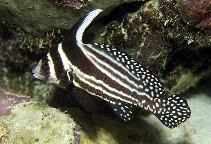| Family: |
Sciaenidae (Drums or croakers) |
| Max. size: |
27 cm TL (male/unsexed) |
| Environment: |
reef-associated; marine; depth range 3 - 30 m |
| Distribution: |
Western Atlantic: Bermuda, Florida (USA), and Bahamas to the Antilles (Ref. 26340) and Yucatan (Mexico) (Ref. 26938) to Brazil. |
| Diagnosis: |
Dorsal spines (total): 11-13; Dorsal soft rays (total): 45-47; Anal spines: 2-2; Anal soft rays: 6-8. First dorsal fin very high with short base. Second dorsal and caudal fins dark with white spots and dashes (Ref. 26938). Head white with two dark brown bars, one through eye, the other more posterior and more diagonal, extending across chest to pelvic fins; body white with a broad dark brown band beginning on front of first dorsal fin, curving across nape, above pectoral fin, and running to mid-base of caudal fin; two narrower dark stripes above and below this band (Ref. 13442). Mouth small, inferior, nearly horizontal. Spinous dorsal fin very elevated, higher than head length. Gas bladder simple, carrot-shaped without appendages. Sagitta (large earstone) near rounded and thick (Ref 51721). |
| Biology: |
Occurs primarily on coral reefs. Secretive and usually solitary, under ledges or near small caves (Ref. 7251). Often seen during the day around the bases of corals (Ref. 26938). Feeds at night on crabs, shrimps, and polychaetes. Easily approached (Ref. 9710). Has been reared in captivity (Ref. 35420). |
| IUCN Red List Status: |
Least Concern (LC); Date assessed: 09 October 2019 Ref. (130435)
|
| Threat to humans: |
reports of ciguatera poisoning |
Source and more info: www.fishbase.org. For personal, classroom, and other internal use only. Not for publication.

